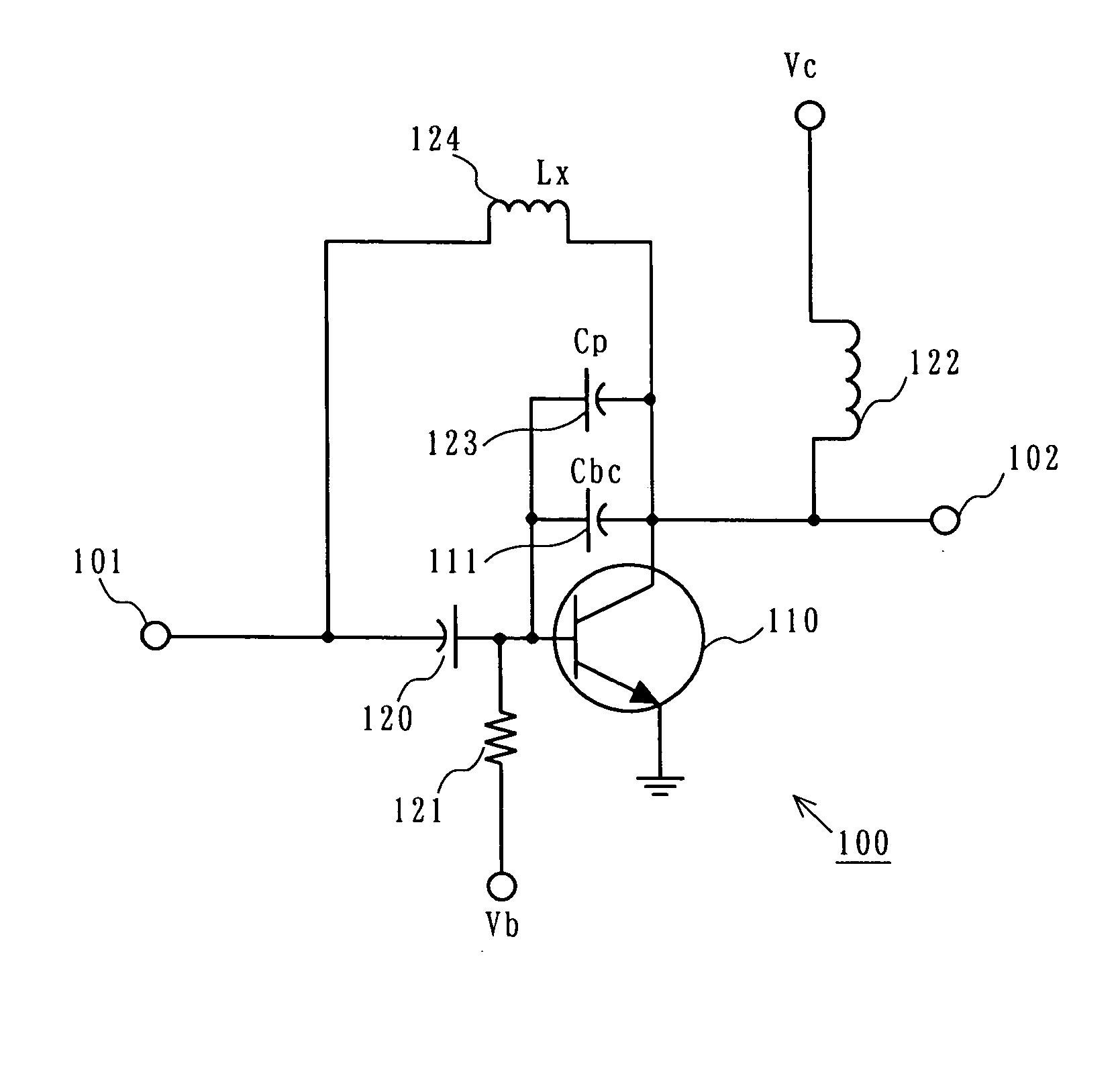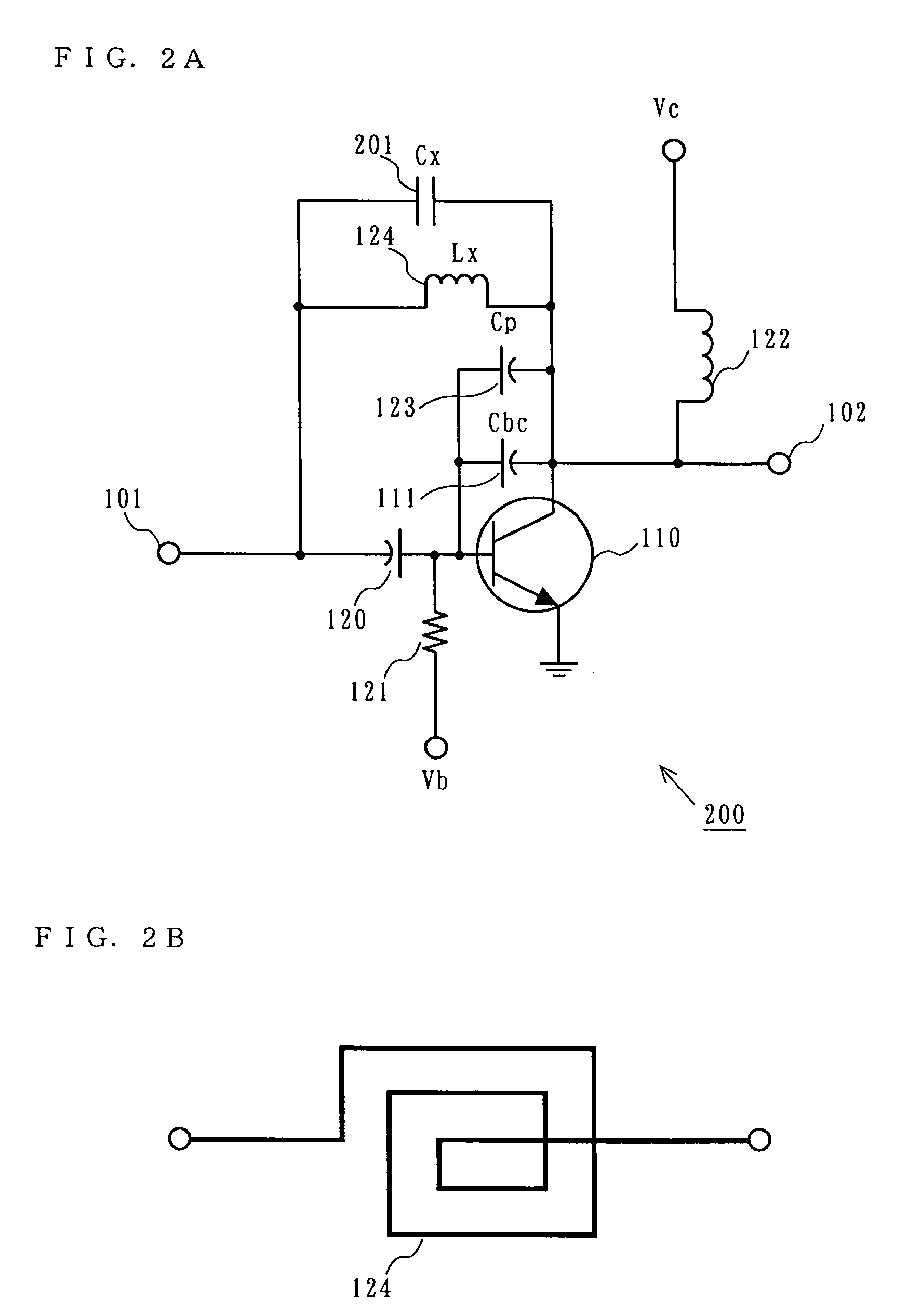Amplifier; and transmitter and communication device incorporating the same
a technology of amplifiers and amplifiers, applied in the field of amplifiers, can solve the problems of deteriorating communication quality, distorted output modulated signal, and inaccurate amplitude information of envelope eo(t), and achieve the effect of wide dynamic range and enhanced power added efficiency
- Summary
- Abstract
- Description
- Claims
- Application Information
AI Technical Summary
Benefits of technology
Problems solved by technology
Method used
Image
Examples
first embodiment
[0074]FIG. 1A is a circuit diagram illustrating the structure of an amplifier 100 according to a first embodiment of the present invention. As shown in FIG. 1A, the amplifier 100 comprises an input terminal 101, an output terminal 102, a transistor 110, a coupling capacitor 120, a resistor 121, an inductor 122, and an inductor 124.
[0075] In the amplifier 100 shown in FIG. 1A, a high-frequency signal which is input via a terminal 101 is applied to a base of a transistor 10. The signal is amplified, led through a collector, and taken out at an output terminal 102 as a transmission signal. To the base, a bias Vb is applied via a resistor 121. To the collector, a bias Vc is applied via an inductor 122.
[0076] Between the base and the collector of the transistor 110, a parasitic capacitor 123 and an intrinsic capacitor 111 are provided in a parallel connection. Furthermore, between the base and collector of the transistor 110, an inductor 124 (having an inductance Lx) is connected. Alth...
second embodiment
[0081]FIG. 2A is a circuit diagram illustrating the structure of an amplifier 200 according to a second embodiment of the present invention. The amplifier 200 shown in FIG. 2A is similar in construction to the amplifier 100 according to the first embodiment except that a further capacitor 201 (having a capacitance Cx) is connected between the base and collector.
[0082] Since the capacitor 201 is in a parallel connection with the parasitic capacitor 123 (having a capacitance Cp) and the intrinsic capacitor 111 (having a capacitance Cbc), the overall capacitance value is increased. Therefore, the value of the reactance Lx which satisfies the relationship of eq. 3 below can be smaller than that which satisfies the relationship of eq. 2:
Lx×(Cbc+Cp+Cx)=1 / ω2 eq. 3.
[0083] The physical size of the inductor can be more reduced as the value of LX decreases. Therefore, according to the second embodiment, by using an inductor 124 having a reactance Lx which satisfies the relationship of eq. ...
third embodiment
[0085]FIG. 3A is a circuit diagram illustrating the structure of an amplifier 300 according to a third embodiment of the present invention. FIG. 3B is a graph showing the frequency characteristics of the gain of the amplifier 300. The amplifier 300 shown in FIG. 3A is similar in construction to the amplifier 200 shown in FIG. 2A, except that a resistor 301 is connected in series with the inductor 124.
[0086] In the amplifier 300, if a parallel resonance circuit 302 which is composed of the parasitic capacitor 123 (having a capacitance Cp), the intrinsic capacitor 111 (having a capacitance Cbc), the inductor 124 (reactance Lx), and the capacitor 201 (having a capacitance Cx) did not have a resistance component, the parallel resonance circuit 302 would have a very large Q value, so that steep changes in impedance would occur along the frequency axis. In order to obtain a uniform gain in a communication band from f1 to f2, for example, such steep changes in the resonance characteristic...
PUM
 Login to View More
Login to View More Abstract
Description
Claims
Application Information
 Login to View More
Login to View More - R&D
- Intellectual Property
- Life Sciences
- Materials
- Tech Scout
- Unparalleled Data Quality
- Higher Quality Content
- 60% Fewer Hallucinations
Browse by: Latest US Patents, China's latest patents, Technical Efficacy Thesaurus, Application Domain, Technology Topic, Popular Technical Reports.
© 2025 PatSnap. All rights reserved.Legal|Privacy policy|Modern Slavery Act Transparency Statement|Sitemap|About US| Contact US: help@patsnap.com



